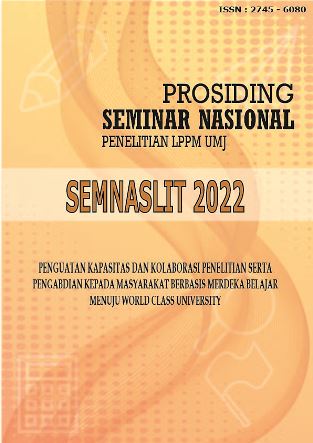Pengaruh Ergonomi terhadap QRM bagi Pekerja Perakitan Mobil Produk Otomotif
Abstract
Otomotif merupakan suatu industri yang berkembang dengan pesat dari tahun ke tahun. Salah satu industri otomotif yang berkembang adalah produksi mobil. Banyak perusahaan yang mengeluarkan produk mobil yang bervariasi dengan harga yang dapat terjangkau oleh masyarakat. Salah satu proses yang memiliki peranan penting dalam menghasilkan unit mobil utuh adalah line perakitan. Proses kerja dilakukan secara manual dan berulang-ulang sehingga memberikan dampak keluhan MSD bagi pekerja perakitan. Proses kerja pemindahan roda mobil dari penyimpanan ke pos pemasangan ke bodi mobil dilakukan secara manual dengan mengangkat roda dari konveyor yang ada saat ini ke tempat penyimpanan dan penyalur roda dengan postur tubuh membungkuk, tangan terbuka dan kaki bertekuk. Sehingga tujuan penelitian ini adalah meminiasi keluhan MSD yang dirasakan pekerja dengan menggunakan pendekatan ergonomic dan QRM. Adapun perbaikan yang dapat dilakukan adalah perancangan ulang konveyor aliran rodan dengan pertimbangan anthropometri dan menghilangkan aktifitas mengangkat dan meletakan roda pada tempat penyimpanan dengan menambahan konveyor yang terhubung ke penyimpanan. Didapatkan hasil penurunan kategori resiko MSD pekerja dari skor 7 menjadi skor 3 dengan kategori :sangat tinggi” menjadi “Sedang”. Artinya bahwa keluhan MSD dapat diminasi dan berdampak juga pada pengurangan penambahan waktu yang dibutuhkan pekerja dalam mencapai target unit produksi. Dan dapat dinyatakan bahwa desain ulang konveyor sangat membantu dalam meminimasi keluhan MSD pekerja perakitan pos roda mobilReferences
Akyol, S. D., & Baykasoglu, A. (2019). ErgoALWABP: a multiple-rule based constructive randomized search algorithm for solving assembly line worker assignment and balancing problem under ergonomic risk factors. Journal of Intelligent Manufacturing, 30(31 january 2019).
Ferguson, S. A., Marras, W. S., Allread, W. G., Knapik, G. G., A, K., Vandlen, Splittstoesser, R. E., & Yang, G. (2011). Musculoskeletal disorder risk as a function of vehicle rotation angle during assembly tasks. Applied Ergonomics, 42, 699–709.
Franzke, B., & Walther, M. (2016). Force-Matching. A New Approach to Determine Action Forces for the Ergonomic Evaluation in Automotive Industry. Advances in Ergonomic Design of Systems, Products and Processes, 361–372.
Giampieri, A., Ling-Chin, J., Ma, Z., Smallbone, A., & Roskilly, A. P. (2020). A review of the current automotive manufacturing practice from an energy perspective. Applied Energy, 261(December 2019). https://doi.org/10.1016/j.apenergy.2019.114074
Godinho., M., & Saes., E. V. (2013). From time-based competition (TBC) to quick response manufacturing (QRM): The evolution of research aimed at lead time reduction. International Journal of Advanced Manufacturing Technology, 64(5–8), 1177–1191. https://doi.org/10.1007/s00170-012-4064-9
Gómez, P. F. J., & Filho, M. G. (2017). Complementing lean with quick response manufacturing: case studies. International Journal of Advanced Manufacturing Technology, 90(5–8), 1897–1910. https://doi.org/10.1007/s00170-016-9513-4
Hamizatun, Zuki, N. M., & Azizul, Q. (2019). Risks assessment at automotive manufacturing company and ergonomic working condition. IOP Conference Series: Materials Science and Engineering, 469(1). https://doi.org/10.1088/1757-899X/469/1/012106
Iranzoa, S., Piedrabuena, A., Iordanov, D., Martinez-Iranzo, U., & Belda-Lois, J.-M. (2020). Ergonomics assessment of passive upper-limb exoskeletons in an automotive assembly plant. Applied Ergonomics, 87. https://doi.org/doi.org/10.1016/j.apergo.2020.103120
Karim, A. N. M., Tuan, S. T., & Kays, H. M. E. (2016). Assembly line productivity improvement as re-engineered by MOST. International Journal of Productivity and Performance Management, 65(7). https://doi.org/10.1108/IJPPM-11-2015-0169
Lima, A. D. de, Bachega, S. jacyszyn, Filho, M. G., Cruz, V. de J. S. da, & Rossi, J. M. (2013). Proposal for implementation of the approach Quick Response Manufacturing (QRM) to reduce lead-time in office operations. SciElo, 23(1).
Mishra, S., Kannan, S., Manager, C., Statistics, A., Comments, R., & Alert, E. (2018). Comparing the Effectiveness of Three Ergonomic Risk Assessment Methods—RULA, LUBA, and NERPA—to Predict the Upper Extremity Musculoskeletal Disorders. Indian Journal of Occupational and Environmental Medicine, 22(1), 17–21. https://doi.org/10.4103/ijoem.IJOEM
Mohamed, N. M. Z. ., & Khan, M. . (2012). Decomposition of manufacturing processes : a review The University of Bradford Institutional Repository. International Journal of Automotive and Mechanical Engineering (IJAME), 5, 545–560. https://doi.org/10.15282
Nelfiyanti., & Mohamed, M. Z. N. (2020). Quick response manufacturing and ergonomic consequences in manufacturing environment. IOP Conference Series: Materials Science and Engineering, 788(1). https://doi.org/10.1088/1757-899X/788/1/012031
Nelfiyanti, & Fauzia, I. M. (2015). Chair Design Work With Ergonomic Aspekct to Reduce Musculoskeletal Complaints PT. Pinaco Main in Indonesia (PUI). ICETIA, 102–105.
Nelfiyanti, & Mohd Zuki Nik Mohamed, N. (2020). Quick response manufacturing and ergonomic consequences in manufacturing environment. IOP Conference Series: Materials Science and Engineering, 788(1). https://doi.org/10.1088/1757-899X/788/1/012031
Nurcahyo, R., & Wibowo, A. D. (2015). Manufacturing capability, manufacturing strategy and performance of Indonesia automotive component manufacturer. Procedia CIRP, 26, 653–657. https://doi.org/10.1016/j.procir.2014.07.046
Ray, P. ., Tewari, V. ., & Saha, E. (2017). Ergonomic Performance and Evaluation of Worksystem : A Few Applications. In M. the A. Century (Ed.), Ergonomic Design of Products and Worksystems-21st Century Perspectives of Asia (Business a, pp. 1–12). Springer, Singapore. https://doi.org/https://doi.org/10.1007/978-981-10-5457-0_1
Rodrigues, M., Loureiro, I., & Leão, C. P. (2019). An Experimental Analysis of Ergonomics in an Assembly Line in a Portuguese Automotive Industry. Occupational and Environmental Safety and Health, 202, 485–491. https://doi.org/doi.org/10.1007/978-3-030-14730-3_52
Rosyati, D., Ahyadi, H., & Nelfiyanti. (2019). Disain Ergonomis Tempat Operasi Khitan untuk Mengurangi Keluhan Muskuloskeletal dengan Metode Rapid Entire Body Assessment (REBA) dan Pengukuran Anthropometri. Bina Teknika, 15(1), 69–76.
Suri, R. (2010). It’s About Time The Competitive Advantage of Quick Response Manufacturing. In A Productivity Press Book (Ed.), CRC Press Taylor&Francis Group.
Szirmai, A., & Verspagen, B. (2015). Manufacturing and economic growth in developing countries, 1950–2005. Structural Change and Ekonomic Dynamics, 34, 46–59. https://doi.org/https://doi.org/10.1016/j.strueco.2015.06.002
Valadkhani, A., & Smyth, R. (2016). The effects of the motor vehicle industry on employment and research innovation in Australia. International Journal of Manpower, 37(4), 684–708. https://doi.org/10.1108/IJM-06-2015-0098
Valamede, L. S., & Lima, M. zuliani T. de. (2019). Technology Ergonomic Innovation Applied At the Final Sector of an Automotive Industry Assembly Line. XXVI Congresso de Iniciação Científica Unicamp, July, 1–1. https://doi.org/10.20396/revpibic.v0i0.id
Wilson, R. (2013). Skills anticipation-The future of work and education. International Journal of Educational Research, 61, 101–110.

